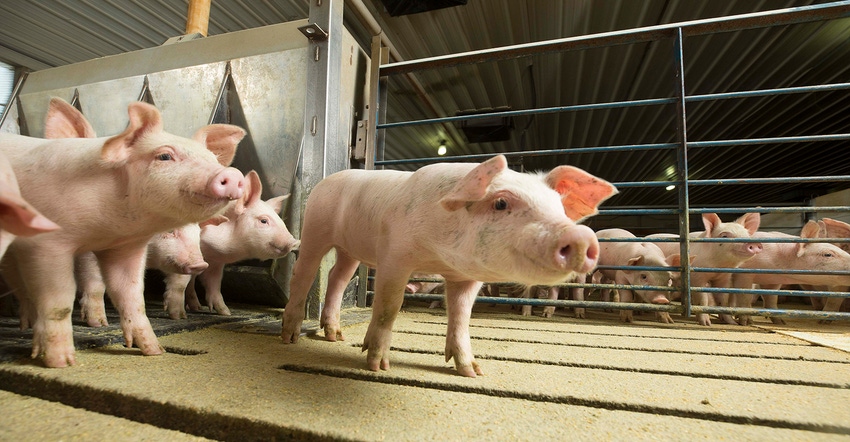Feeding low crude protein diets reduce diarrhea in weanling pigs as indicated by the improved fecal scores.
July 30, 2020

Reduced concentration of dietary crude protein in diets for weanling pigs limits the amounts of non-digested protein entering the hindgut of the pigs. Because the nitrogen from the undigested feed protein will be fermented in the hindgut it may create an environment in which pathogenic bacteria can proliferate, which may lead to diarrhea and reduced intestinal health.
It was, therefore, hypothesized that when feeding weaned pigs low crude protein diets, the frequency of diarrhea will be reduced and intestinal health will be improved, whereas the impact on growth performance will be negligible.
Corn-soybean meal based diets were used to formulate treatments diets containing 22, 19 or 16% crude protein. A Phase 1 diet was provided for the initial seven days post-weaning and the Phase 2 diet was fed during the following 21 days. The 22% and the 19% diets were formulated to meet the requirement for all indispensable amino acids in both phases and the difference between the two diets was that a greater concentration of crystalline AA and less soybean meal was included in the 19% diet compared with the 22% diet (Table 1).

However, in the 16% diet, the Phase 1 diet provided amino acids at 71% of the requirement, and the Phase 2 diet provided amino acids at 81% of the requirement. The limiting amino acid was phenylalanine in the Phase 1 diet and histidine in the Phase 2 diet.
On the day of weaning 180 weaned pigs (approximately 20 days old; 5.5 ± 0.9 kilograms) were allotted to the three dietary treatments with five pigs per pen and 12 replicate pens per treatment. Individual pig body weight was recorded on the day of weaning and weekly thereafter. Daily feed provisions were recorded as well and at the end of each phase, average daily gain, average daily feed intake and average gain-to-feed ratio were calculated. Throughout the experiment, fecal scores were recorded for each pen every other day. One pig per pen was euthanized on Day 12 and samples of the jejunum and ileum were collected for morphology measurements.
Results demonstrated that there was a linear (P < 0.05) decrease in fecal score on Day 1 to 7, Day 8 to 14 and overall from Day 1 to 28, if crude protein in the diet was reduced (Table 2). These data demonstrate that as hypothesized, the incidence of diarrhea was reduced as dietary crude protein was reduced.

However, there was also a tendency (P = 0.071) for a linear decrease in average daily gain and a linear (P < 0.05) decrease in the gain:feed ratio from Day 1 to 14 if dietary crude protein was reduced (Table 3). Likewise, from Day 14 to 28, there was a linear (P < 0.05) decrease in average daily gain and a quadratic (P < 0.05) decrease in G:F when dietary crude protein was reduced and this was also the case for the overall period from Day 1 to 28.

Likewise, final body weight of pigs was reduced (linear, P < 0.05) as dietary crude protein was reduced, but these negative effects of reducing dietary crude protein were mainly due to the 16% crude protein diets.
There was also a quadratic (P < 0.05) effect of dietary crude protein on villus height in the jejunum, and pigs consuming the 19% crude protein diet had the greatest villus height, indicating an increased surface area for nutrient absorption (Table 4). The same quadratic (P < 0.05) effect was observed for the villus height:crypt depth ratio in the jejunum.

There was also a quadratic (P < 0.05) effect on crypt depth in the ileum, where pigs consuming the 19% crude protein diet had the shallowest crypt depth and pigs consuming the 22% crude protein diet had the greatest crypt depth. The increase in crypt depth that may result from consuming more soybean-meal (and increased crude protein) may also be associated with the increased fecal score that was observed.
In conclusion, feeding low crude protein diets reduce diarrhea in weanling pigs as indicated by the improved fecal scores obtained in this experiment. It also appears that reducing crude protein may have beneficial effects on intestinal health as indicated by the improved intestinal morphology.
However, under the conditions of the present experiment, these improvements were not big enough to offset negative effects of low protein diets on growth performance. It is, however, possible that if the low protein diets are fed for only two weeks post-weaning instead of four weeks, pigs will be able to compensate for the lower growth performance during the initial two weeks post-weaning before the end of the nursery period.
Sources: Joseph R. Limbach, Charmaine D. Espinosa and Hans H. Stein, who are solely responsible for the information provided, and wholly own the information. Informa Business Media and all its subsidiaries are not responsible for any of the content contained in this information asset.
You May Also Like



